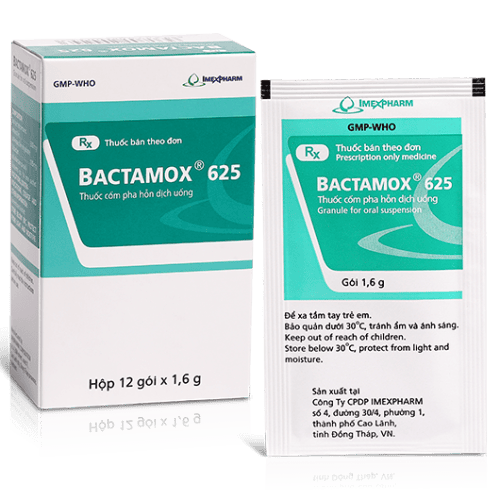This is an automatically translated article.
Amoxicillin is a beta-lactam antibiotic with a broad spectrum of action, but is less effective against beta-lactamase-producing strains, requiring combination with another agent Sulbactam. This combination is in the drug Zoxaci. So what does Zoxaci do?
1. What does Zoxaci do?
What does Zoxaci do? Zoxaci contains Amoxicillin (as Amoxicillin trihydrate) 500mg and Sulbactam (as Sulbactam pivoxil) 250mg.Zoxaci products are prepared in the form of film-coated tablets, packed in each box of 5 blisters x 10 tablets, circulated with the registration number VD-24198-16 produced by Ha Tay Pharmaceutical Joint Stock Company. Amoxicillin in Zoxaci is a semi-synthetic beta-lactam antibiotic with a broad spectrum of activity against many Gram-positive and Gram-negative bacteria through inhibition of bacterial cell wall synthesis. Because Amoxicillin is easily destroyed by beta-lactamase enzymes, it is not effective against strains of bacteria that produce this enzyme (including many strains of Enterobacteriaceae and Haemophilus influenzae). The remaining active ingredient in Zoxaci is Sulbactam which is a competitive, irreversible inhibitor of the enzyme beta-lactamase. The presence of Sulbactam in the Zoxaci component increases the effect and broadens the antibacterial spectrum of Amoxicillin against beta-lactamase-producing bacteria.
2. Indications and contraindications of Zoxaci
Zoxaci is indicated for the treatment of infections caused by susceptible bacteria, including:
Ear, nose and throat infections such as tonsillitis, sinusitis or otitis media; Lower respiratory tract infections such as acute and chronic bronchitis, bronchopneumonia; Genitourinary tract infections such as cystitis, urethritis, pyelonephritis, female genital tract infections; Skin and soft tissue infections, including boils, abscesses, wound infections; Bone and joint infections; Some other infections such as infections caused by abortion, obstetric infections or abdominal infections. Contraindications of Zoxaci:
Patients with hypersensitivity to Amoxicillin, Sulbactam or excipients in Zoxaci; Patients with hypersensitivity to penicillins and other cephalosporins; Patients with a history of gastrointestinal disease, especially ulcerative colitis, Crohn's disease or antibiotic-associated colitis; People with a history of jaundice or liver dysfunction.
3. Dosage of Zoxaci
Zoxaci products are prepared in the form of film-coated tablets for oral use, patients can take the drug before or after meals.
The recommended dose of Zoxaci according to specific Amoxicillin antibiotics is as follows:
Adults and children weighing over 40kg: 1 Zoxaci tablet x 3 times a day; Children weighing less than 40kg: The recommended dose is 20-40mg/kg/day, divided into 3 doses depending on the degree of infection; The duration of Zoxaci should be maintained until at least 2-3 days after the symptoms of infection improve. However, Zoxaci should not be used for more than 14 days without being reviewed by a doctor; Dosage of Zoxaci in patients with renal impairment (amoxicillin dose) should be adjusted according to creatinine clearance:
ClCr < 10 mL/min: Recommended dose 250-500 mg every 24 hours, depending on severity of bacterial infection; ClCr 10-30 mL/min: The recommended dose is 250-500 mg every 12 hours, depending on the severity of the infection; Hemodialysis patients: 250-500 mg every 24 hours and 1 additional dose after each dialysis session. Zoxaci drug overdose and management:
Zoxaci rarely causes complications due to its good tolerability even at high doses. The occurrence of acute reactions depends on the hypersensitivity of the individual. In case of overdose, the patient should stop taking Zoxaci immediately and seek appropriate supportive measures, possibly causing vomiting, gastric lavage; Zoxaci has no specific antidote, however Amoxicillin and Sulbactam can be removed from the body by hemodialysis.
4. Side effects of the drug Zoxaci
The most common adverse effects in patients treated with Zoxaci are diarrhea, itching or rash.
A small number of patients presented with nausea, vomiting, eosinophilia, rash, hepatitis, cholestatic jaundice or increased transaminases during the use of Zoxaci.
In particular, some very rare side effects of Zoxaci include:
Agitation, anxiety, mental anxiety; Anaphylactic reactions, Quincke's edema; Mild decrease in platelet count, leukopenia, hemolytic anemia; Pseudomembranous colitis; Stevens-Johnson syndrome, toxic epidermal necrolysis; Interstitial nephritis. Patients need to inform the doctor about the unwanted effects encountered when using Zoxaci medicine.
5. Zoxaci Drug Interactions
Possible drug interactions of Zoxaci are as follows:
Zoxaci may prolong bleeding and clotting time, so caution should be exercised when combining with anticoagulants; Zoxaci may decrease the effectiveness of oral contraceptives, so physicians should warn patients about this interaction; Probenecid reduces the renal tubular excretion of Zoxaci; Nifedipine increases the absorption of Amoxicillin in Zoxaci when used concomitantly; Amoxicillin reduces the excretion of Methotrexate , which in turn may increase toxicity on the gastrointestinal tract and hematopoietic system; Concomitant use of Zoxaci with allopurinol increases the risk of allergic skin reactions; Chloramphenicol, the antibiotics Macrolide, Sulfamide and Tetracycline may interfere with the bactericidal effect of Amoxicillin in Zoxaci.
6. Precautions when using Zoxaci
Use caution when using Zoxaci in the following cases:
During treatment with Zoxaci, patients must be periodically tested to check liver function. Signs and symptoms of cholestatic jaundice are rare with Zoxaci, but if they do, they are often severe. However, this side effect is usually reversible and completely gone 6 weeks after stopping Zoxaci. Serious and sometimes fatal hypersensitivity reactions (anaphylaxis) to Zoxaci have been reported. Zoxaci is recommended to be avoided in patients with suspected infectious mononucleosis. As with other antibiotics, prolonged use of Zoxaci sometimes leads to the development of resistant strains of bacteria. Use of Zoxaci in pregnant women: Experimental studies on animal reproduction (rats) have demonstrated that oral administration of Amoxicillin/Sulbactam preparations does not cause fetal malformations. However, because there is no scientific document on the use of Zoxaci for pregnant women, it is necessary to avoid using this product, especially in the first 3 months of pregnancy, unless it is necessary by the doctor's instructions. determined. Use of Zoxaci in breast-feeding patients: Amoxicillin/sulbactam is excreted in breast milk, so caution should be exercised when Zoxaci is used in this patient. Effects on ability to drive and use machines: Zoxaci has no influence on the ability to drive or use machines. Zoxaci contains Amoxicillin 500mg and Sulbactam 250mg. The drug is indicated for the treatment of certain infectious diseases. To ensure the effectiveness of treatment and avoid unwanted side effects, patients need to strictly follow the instructions of the doctor, professional pharmacist.
Follow Vinmec International General Hospital website to get more health, nutrition and beauty information to protect the health of yourself and your loved ones in your family.
Please dial HOTLINE for more information or register for an appointment HERE. Download MyVinmec app to make appointments faster and to manage your bookings easily.













